The Weekly Anthropocene, October 4 2023
Spectacular news on global clean energy growth, enhanced geothermal as a new champion, rhino numbers on the rise in Africa, migration-recalibrating bird taxi drivers, and more!
The Big Picture
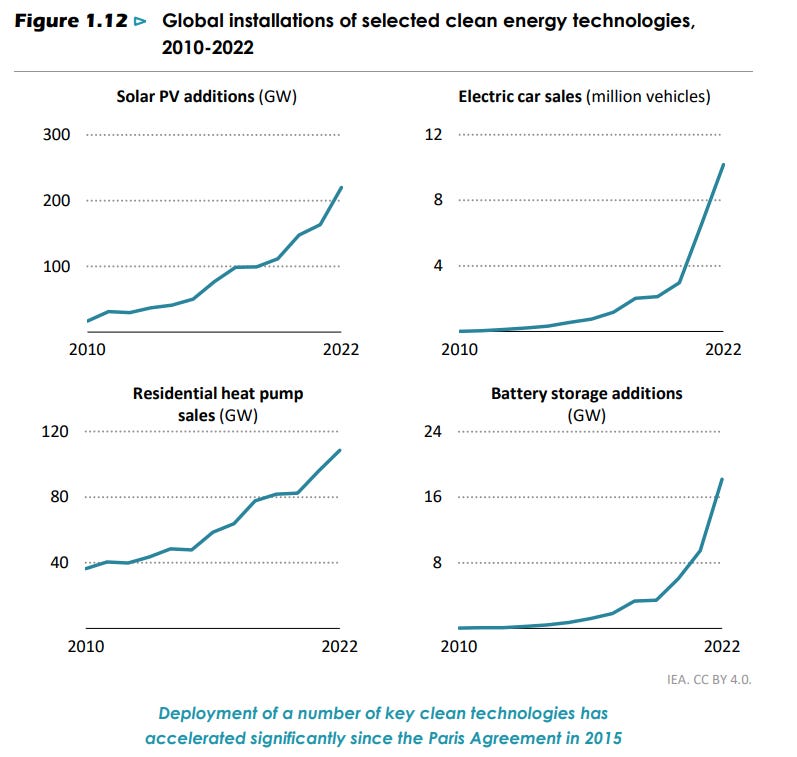
A landmark new International Energy Agency report just came out, providing a comprehensive update on humanity’s progress towards decarbonizing our civilization and limiting climate change impacts. There’s a lot of incredible progress to report!
To hyper-summarize (check out the full report here, and here’s the PDF): as the beautiful graph above depicts1, clean energy technologies are growing faster than 2005-era environmentalists’ wildest dreams. As the report notes, “This progress reflects cost reductions for key clean energy technologies – solar PV, wind, heat pumps and batteries – which fell by close to 80% on a deployment weighted average basis between 2010 and 2022.” Global energy sector emissions are now expected to peak around 2025 and fall to approximately 2015 levels by 2030. Economics is now pushing in the direction of more and more clean energy and lower emissions! This is one of the most underreported stories in the world.
All that has added up to a big shift, in a good direction, of expected global warming. The new IEA report calculates that due to rapid renewables growth, we’re currently on track for 2.4°C of warming above pre-industrial conditions by 2100, and it’s still possible that we could hold warming to as low as 1.5°C by 2100 (the Paris Agreement goal) with extra effort. This is amazing progress! As recently as 2011, the worst-case “RCP 8.5” global warming scenario still seemed plausible, which in the “worst case of the worst case” could have led to warming as high as 4.8°C by 21002. We’re now on a much better path, and we can do better still!
Rhinos
The IUCN African Rhino Specialist Group has released a new report on the state of Africa’s two rhino species. Africa’s white and black rhinos have both seen their populations increase in recent years thanks to assiduous conservation efforts!
Southern white rhino (Ceratotherium simum) numbers3 have risen to 16,803 at the end of 2022 up from 15,942 at the end of 2021 and just 20 in the year 1900. (Numbers were slightly higher in the mid-2010s, as a poaching surge took its toll, but this year may have turned the tide: 2022 is the first year that the Southern white rhino population has increased since 2012).
Black rhino (Diceros bicornis) now number 6,487, up from 6,195 at the end of 2021 and around 2,500 in the early 1990s.
For non-African rhinos, the greater one-horned (or Indian) rhino, native to India and Nepal, remains stable with a population of around 4,000, up from possibly as low as 40 in the 1960s.
Sadly, the two Indonesian rhino species remain on the edge of extinction, with an estimated 76 Javan rhinos and possibly as low as 34 Sumatran rhinos. However, the example of the white and Indian rhinos’ epic comebacks show that there is still a chance to save the Javan and Sumatran species—possibly helped by the cryopreserved genetic samples of Sumatran rhino DNA at the Frozen Zoo which may allow us to “de-extinct” them in the near future. This technology is currently being trialed with the near-lost Northern white rhino subspecies, which has only two living females but also 12 frozen embryos produced with frozen genetic material.
The noble and ancient lineage of the rhinoceros was almost wiped off the face of the planet in the twentieth century—but they’re now making a comeback! With compassion and ingenuity, dedicated people are striving to keep these incredible creatures alive.
Pied Flycatchers
The Dutch population of European pied flycatchers (Ficedula hypoleuca) have migrated from their wintering spots in West Africa to their summer nesting grounds in the Netherlands for generations, but lately their arrival has been falling out of sync with caterpillar hatching times due to climate change scrambling the seasons, leading to hungry nestlings and declining populations. Now, a new paper has been published in Nature Ecology & Evolution sharing a successful intervention by scientists to “recalibrate” their migration for a warmer world. Starting in 2017, the researchers caught female pied flycatchers arriving in the Netherlands and physically drove them 570 kilometers to a nesting spot in Sweden (already home to several Swedish-population European pied flycatchers). They stuck with the new spot, returning to Sweden the next year. And at the Swedish nesting spot, spring starts two weeks later—meaning the caterpillar emergence now matched the Dutch flycatchers’ (likely genetically hardwired) migration timing4. Furthermore, in the course of their research, the scientists also discovered that some Dutch flycatchers had been already been found flying further north (to the Schleswig-Holstein region of Germany, about halfway to Sweden). The intervention had helped speed up the birds’ efforts to adapt to climate change on their own.
Perhaps in the near future, “migration-recalibrating bird taxi driver” can become an emerging conservation job of the Anthropocene! Great work.
Bhutan
As The Weekly Anthropocene has previously discussed, it’s hard to know how many snow leopards there are; these “ghosts of the mountain” live in remote mountain areas where cliffs scatter radio signals and the cold perma-freezes genetic material in scat, making it hard to tell if samples are from a current population or long-dead individuals. Now, we have concrete evidence of increasing snow leopard populations in at least one country. The National Snow Leopard Survey of the remote Himalayan kingdom of Bhutan5 has counted 134 snow leopards using a vast network of camera trap stations, a 39.5% increase from the 96 snow leopards counted in 2016. Great news!
United States
The Weekly Anthropocene was incredibly psyched after Fervo Energy’s successful breakthrough in enhanced geothermal technology in July 2023, when their “Project Red” test in Nevada successfully produced 3.5 megawatts of power. Enhanced geothermal systems (EGS) produce energy by drilling deep wells, injecting water underground until it heats up, and then drilling another well to let that water rise back up and turn a turbine, producing emissions-free electricity.
Now, Fervo Energy has built on their Project Red success with a much larger commercial-scale enhanced geothermal project. Drilling has started at Cape Station in Beaver County, Utah6, set to become a 400-megawatt clean energy facility by 2028!
There’s a lot of good news here, but to get an idea of just how incredible the potential is, here are two vital points about EGS:
It can be done at night and in any weather, providing 24/7 “baseload power.”
And it can use the huge amount of existing drilling technology we have lying around from the oil and gas industry.
Fervo Energy is at the forefront of what is poised to be a transformative new field of clean energy technology, hopefully soon rivaling solar and wind in a speedy rollout to provide clean, zero-emissions energy to human technological civilization! Within a few years, geothermal drilling rigs could be right up there with wind turbines and solar panels as rapidly-proliferating symbols of a clean, abundant future. When and if they come to your neighborhood, be sure to welcome them! Spectacular news!
Maxeon, a manufacturer of ultra-high-performance solar panels, is awaiting the finalization of a Department of Energy loan to go ahead with their project of building a massive solar panel factory near Albuquerque, New Mexico. Even in the context of the post-Inflation Reduction Act solar manufacturing building boom, this would be huge: the Maxeon factory would produce 3 gigawatts (3,000 MW) of solar panels per year, while the entire U.S. solar industry produced 5 gigawatts as recently as 2022, the last pre-IRA year. Construction is likely to begin in 2024. Great news!
25 American utilities, from states-spanning companies to individual city power districts, have now joined the “2030 Club,” a group of electricity providers voluntarily working towards 80% carbon emissions reductions (or 80% clean energy) by 2030!
Grid-scale batteries quietly saved much of the American grid from outages during the summer of 2023. In Texas, which saw record heat waves straining electricity supply, grid battery capacity having risen from 275 MW in 2020 to 3,500 MW in 2023 was key to keeping the lights on in high-demand evening hours. Clean energy technologies don’t just help us address the root causes of climate change-they help us weather its impacts!
On July 7, 2023, the United States of America destroyed the very last of its stockpile of chemical weapons, a lengthy process that began with the international Chemical Weapons Convention going into effect in 1997. (Destroying chemical weapons safely is difficult, especially once you factor in lawsuits between people with differing ideas of “safely”). Check out this article for the full fascinating story. Great news!
This kind of data is why this writer is notably more optimistic on climate change than many others—even a relatively well-informed climate-concerned person will have missed huge positive changes if they haven’t checked in with global energy statistics since, say, 2019. The renewables revolution is going exponential!
For context, the last Ice Age was about 6°C colder: we want to avoid that magnitude of global mean temperature change.
Imagine how this must have felt from a Dutch flycatcher’s perspective: they have genetic migration instincts and routes learned from their parents, not Google Maps, so they had no way of knowing that Sweden exists or would provide caterpillars at the appropriate time. Once transported there, caterpillars were finally available at the right time; the world was set to rights again.
The constitutional monarch of Bhutan’s official title is Druk Gyalpo, or Dragon King. This has nothing to do with the snow leopard survey, but it’s too cool not to mention. You live in a world where an actual living person, Jigme Khesar Namgyel Wangchuck, has the job title of Dragon King.
Notably, Republican Utah Governor Spencer Cox was on the scene to celebrate alongside Biden Administration officals. Geothermal has the potential to win substantial bipartisan support in the United States, in large part because its use of drilling technologies means it could provide a neat “offramp” from fossil fuels for oil and gas companies and employees.




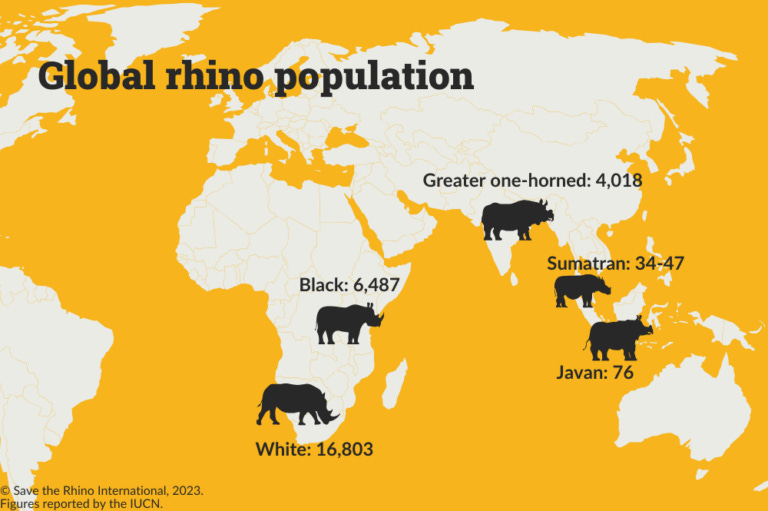
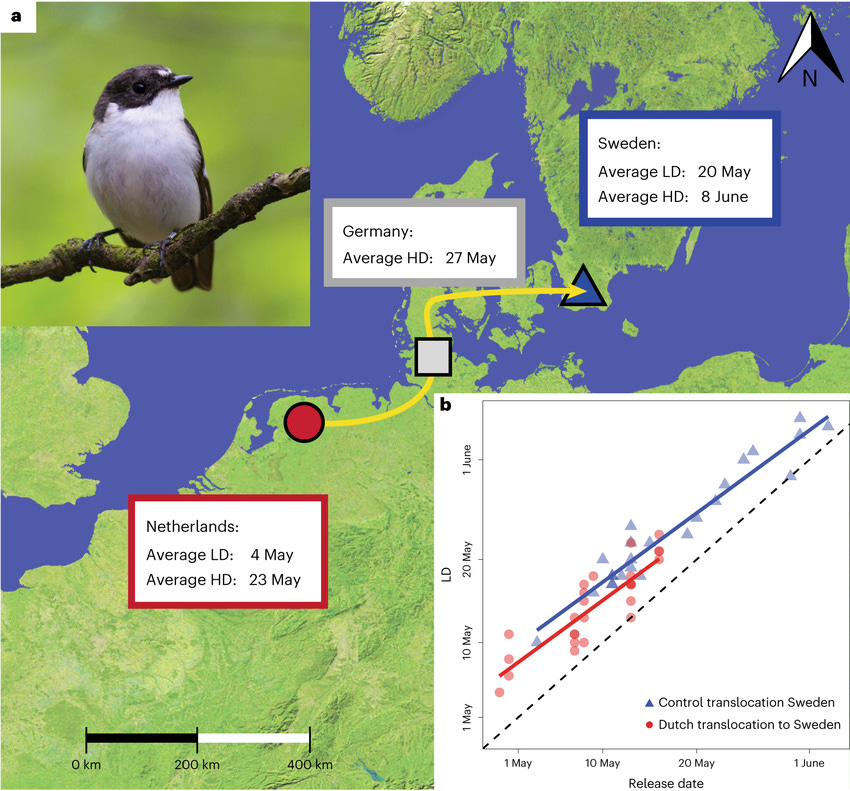
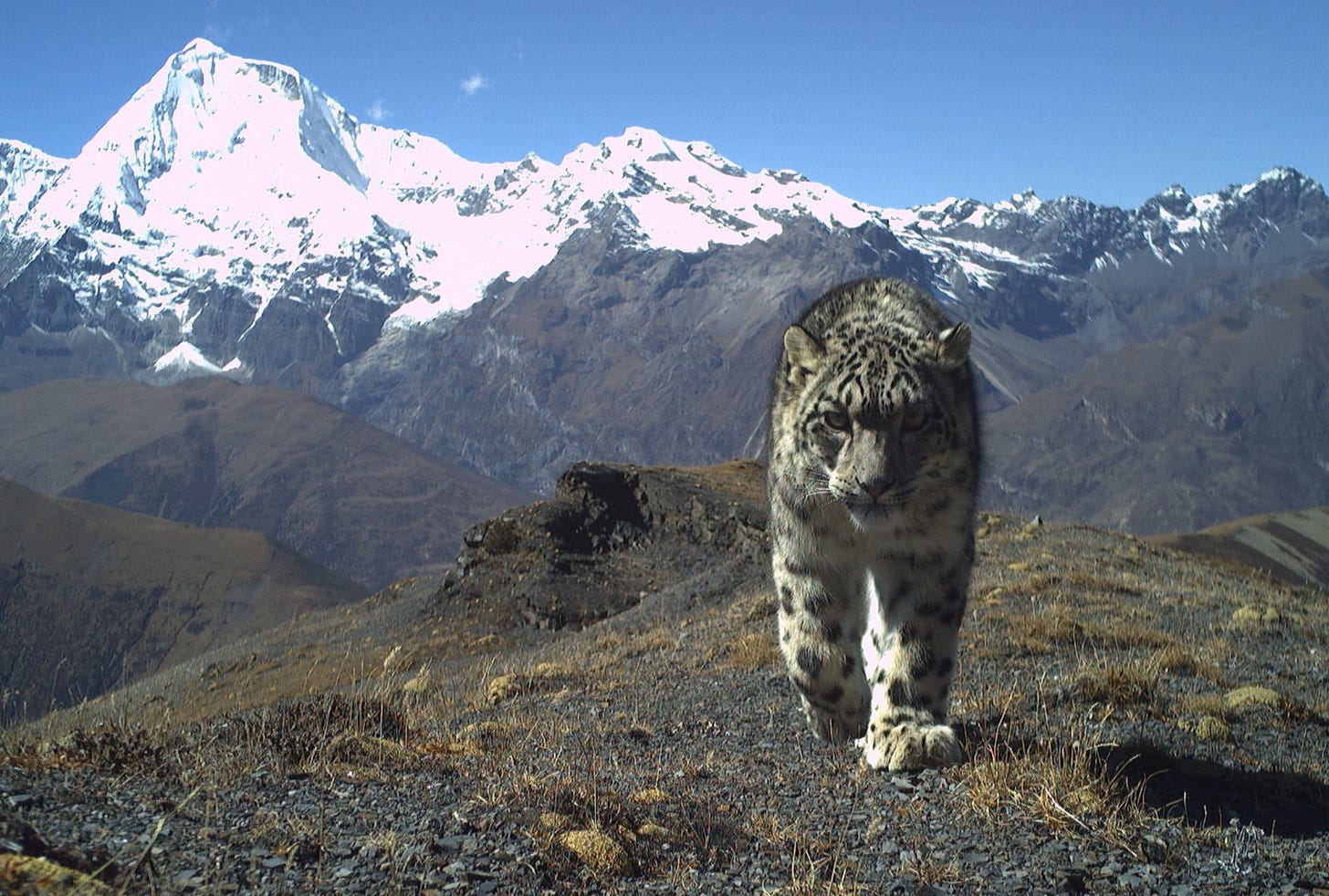
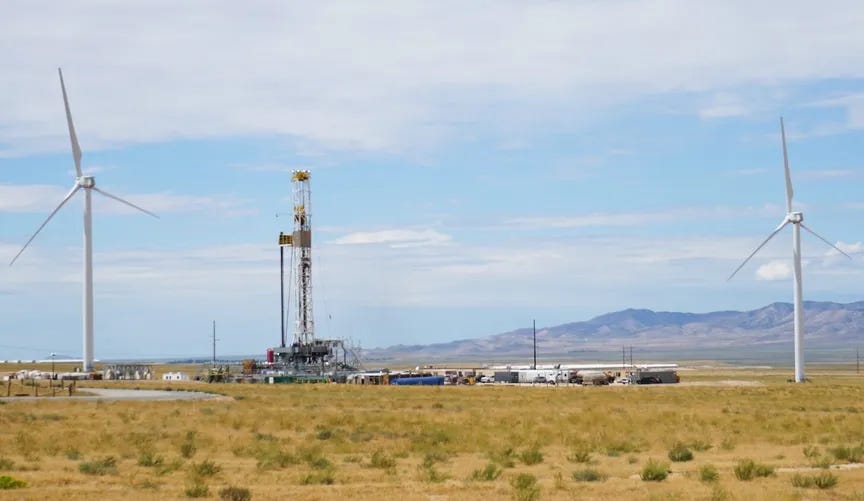
Great causes for optimism! My favorite parts were those about geothermal (I ❤️ geothermal!) and the little out-of-synch birds and their caterpillars! What a genius idea to recalibrate them by force majeure rather than wait to see if they could ever figure it out by natural selection and trial and error. (Which they might not have achieved in ). I can see us playing this role for lots of species that can't adapt as fast as the changes are coming.
Would love to see an issue of your newsletter devoted to geothermal! Definitely superior to windpower and less a ghastly disfigurement of the natural environment. As well as being more reliable and in near infinite supply.